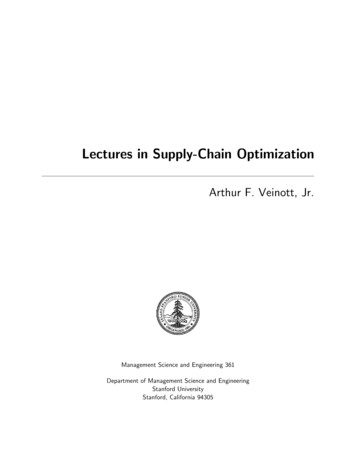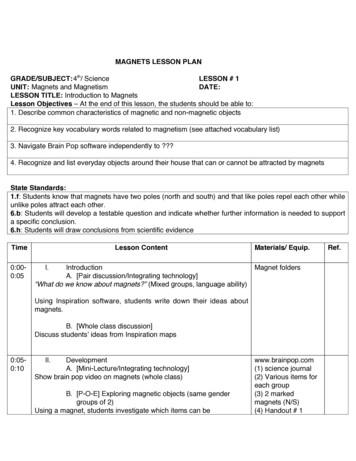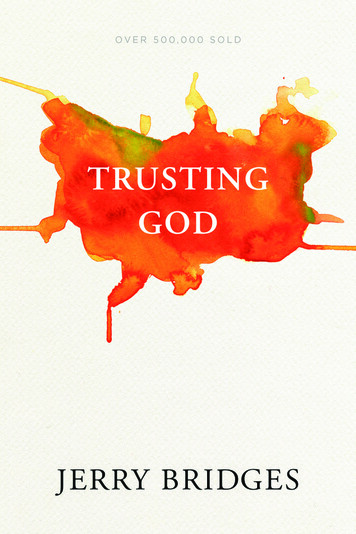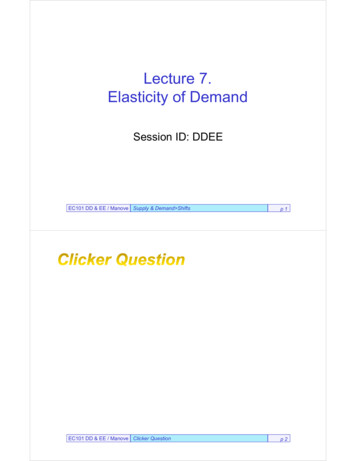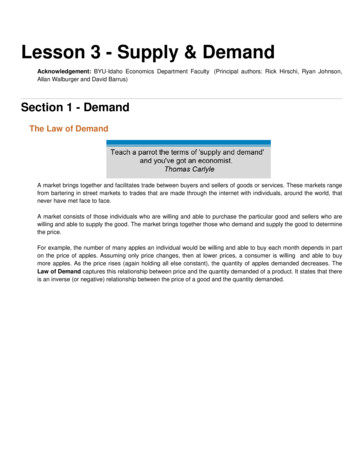
Transcription
Lesson 3 - Supply & DemandAcknowledgement: BYU-Idaho Economics Department Faculty (Principal authors: Rick Hirschi, Ryan Johnson,Allan Walburger and David Barrus)Section 1 - DemandThe Law of DemandA market brings together and facilitates trade between buyers and sellers of goods or services. These markets rangefrom bartering in street markets to trades that are made through the internet with individuals, around the world, thatnever have met face to face.A market consists of those individuals who are willing and able to purchase the particular good and sellers who arewilling and able to supply the good. The market brings together those who demand and supply the good to determinethe price.For example, the number of many apples an individual would be willing and able to buy each month depends in parton the price of apples. Assuming only price changes, then at lower prices, a consumer is willing and able to buymore apples. As the price rises (again holding all else constant), the quantity of apples demanded decreases. TheLaw of Demand captures this relationship between price and the quantity demanded of a product. It states that thereis an inverse (or negative) relationship between the price of a good and the quantity demanded.
Lesson 3 - ECON 150- Revised Fall 2014 .nbDownward Sloping Demand for ApplesAs the price of apples increase, the quantity demanded decreases. This is because consumers demand lessat a higher price. As the price of apples decreases,the quantity demanded increases since consumers demandmore at a lower price. This is the law of demand.Table for DemandPrice510152025303540No. of Apples302522181512105Price2Quantity Demanded of ApplesOriginal source code for graph above from Javier Puertolas. Modified by David Barrus and Victoria Cole.Demand CurveRecall, that we represent economic laws and theory using models; in this case we can use a demand schedule or ademand curve to illustrate the Law of Demand. The demand schedule shows the combinations of price andquantity demanded of apples in a table format. The graphical representation of the demand schedule is called thedemand curve.When graphing the demand curve, price goes on the vertical axis and quantity demanded goes on the horizontalaxis. A helpful hint when labeling the axes is to remember that since P is a tall letter, it goes on the vertical axis.Another hint when graphing the demand curve is to remember that demand descends.The demand curve reflects our marginal benefit and thus our willingness to pay for additional amounts of a good. Itmakes sense that our marginal benefit, or willingness to pay for a good, would decline as we consume additionalunits because we get less additional satisfaction from each successive unit consumed. For example, at lunch timeyou decide to buy pizza by-the-piece. You’d be willing to pay a lot for that first piece to satisfy your hunger. But whatabout the second piece? Perhaps a little less. If we keep considering each additional piece, we might ask what the3rd, 4th or 5th piece is worth to you. By that point, you’d be willing to pay less, perhaps much less. The law ofdemand and our models illustrate this behavior.A more formal examination of the law of demand shows the most basic reasons for the downward sloping nature ofdemand. The first is the substitution effect which states that as the price of the good declines, it becomes relativelyless expensive compared to the price of other goods, and thus the quantity demanded is greater at a lower price.When the price of the good rises, the opposite occurs; that is, as the price of the good becomes relatively moreexpensive compared to other goods a lower quantity will be demanded. For example, as the price of applesincreases or decreases, apples become relatively more or less expensive compared to other goods, such asoranges. Thus if the price of apples declines, consumers will buy more apples since they are relatively less expensive compared to other goods, such as oranges.The second factor is the income effect which states that as the price of a good decreases, consumers becomerelatively richer. Now, their incomes have not increased, but their buying power has increased due to the lower price.
Lesson 3 - ECON 150- Revised Fall 2014 .nb3If they continued to buy the same amount, they would have some money left over - some of that extra money couldbe spent on the good that has the lower price, that is quantity demanded would increase. On the other hand, as theprice of a good increases, then the buying power of individuals decreases and the quantity demanded decreases.For example, at 20 cents per apple, we are able to purchase 5 apples for 1 but if the price falls to 10 cents, wewould be able to buy 10 apples for 1. Although our income has not changed, we have become relatively richer.At this point, we have explained why there is an inverse relationship between price and quantity demanded (i.e.we've explained the law of demand). The changes in price that we have discussed cause movements along thedemand curve, called changes in quantity demanded. But there are factors other than price that cause completeshifts in the demand curve which are called changes in demand (Note that these new factors also determine theactual placement of the demand curve on a graph).While a change in the price of the good moves us along the demand curve to a different quantity demanded, achange or shift in demand will cause a different quantity demanded at each and every price. A rightward shift indemand would increase the quantity demanded at all prices compared to the original demand curve. For example, ata price of 40, the quantity demanded would increase from 40 units to 60 units. A helpful hint to remember that moredemand shifts the demand curve to the right. Move the slider on the graph below to see the rightward shift.A leftward shift in demand would decrease the quantity demanded to 20 units at the price of 40. With a decrease indemand, there is a lower quantity demanded at each an every price along the demand curve. Move the slider on thegraph below to see the leftward shift.Factors that Shift the Demand CurveThe factors listed below will shift the demand curve either to the right or to the left.Demand Curve ShiftsUse the slider bar to shift the demand curve from left to right.Shifts in the Demand CurveLeft.RightFactors that Cause Demand to Shift1. Changes in Tastes & Preferences2. Changes in Prices of Related Goods3. Changes in Income4. Expectations of Future Prices5. Number of BuyersResetOriginal source code for graph above from Javier Puertolas. Modified by David Barrus and Victoria Cole.1. Change in Tastes and PreferencesA change in tastes and preferences will cause the demand curve to shift either to the right or left. For example, if newresearch found that eating apples increases life expectancy and reduces illness, then more apples would be pur-
4Lesson 3 - ECON 150- Revised Fall 2014 .nbchased at each and every price causing the demand curve to shift to the right. Companies spend billions of dollars inadvertising to try and change individuals' tastes and preferences for a product. Celebrities or sports stars are oftenhired to endorse a product to increase the demand for a product. A leftward shift in demand is caused by a factorthat adversely effects the tastes and preferences for the good. For example, if a pesticide used on apples is shown tohave adverse health effects.2. Changes in Prices of Related GoodsAnother factor that determines the demand for a good is the price of related goods. These can be broken down intotwo categories – substitutes and complements. A substitute is something that takes the place of the good.Instead of buying an apple, one could buy an orange. If the price of oranges goes up, we would expect an increase indemand for apples since consumers would move consumption away from the higher priced oranges towards appleswhich might be considered a substitute good. Complements, on the other hand, are goods that are consumedtogether, such as caramels and apples. If the price for a good increases, its quantity demanded will decrease and thedemand for the complements of that good will also decline. For example, if the price of hot dogs increases, one willbuy fewer hot dogs and therefore demand fewer hot dog buns, which are complements to hot dogs.3. Changes in IncomeRemember that demand is made up of those who are willing and able to purchase the good at a particular price.Income influences both willingness and ability to pay. As one's income increases, a person's ability to purchase agood increases, but she/he may not necessarily want more. If the demand for the good increases as income rises,the good is considered to be a normal good. Most goods fall into this category; we want more cars, more TVs, moreboats as our income increases. As our income falls, we also demand fewer of these goods. Inferior goods have aninverse relationship with income. As income rises we demand fewer of these goods, but as income falls we demandmore of these goods. Although individual preferences influence if a good is normal or inferior, in general, TopRamen, Mac and Cheese, and used clothing fall into the category of an inferior good.4. Expectations of the FutureAnother factor of demand is future expectations. This includes expectations of future prices and income. An individual that is graduating at the end of the semester, who has just accepted a well paying job, may spend more todaygiven the expectation of a higher future income. This is especially true if the job offer is for more income than whathe had originally anticipated. If one expects the price of apples to go up next week, she will likely buy more applestoday while the price is still low.5. Number of BuyersThe last factor of demand is the number of buyers. A competitive market is made up of many buyers and manysellers. Thus a producer is not particularly concerned with the demand of one individual but rather the demand of allthe buyers collectively in that market. As the number of buyers increases or decreases, the demand for the goodwill change.Market DemandThe market demand is determined by the horizontal summation of the individual demands. For example, at 20 centsper apple, Kelsey would buy 20 apples, Scott would buy 10 apples, making the market quantity demanded at 20cents equal to 30 apples.When determining the market demand graphically, we select a price then find the quantity demanded by each individual at that price. To determine the entire demand curve, we would then select another price and repeat the process.
Lesson 3 - ECON 150- Revised Fall 2014 .nb5Market Demand CurveImagine Kelsey and Scott are they only two consumers in a market. Click on each price to see how their quantity demandedchanges. Market demand is a horizontal summation of individual demands.Price403530252015105Individual and Market DemandPriceKelsey's Quantity DemandedScott's Quantity DemandedMarket Quantity Demand40022.ResetOriginal source code for graph above from Javier Puertolas. Modified by David Barrus and Victoria Cole.Demand vs. Quantity DemandedAt this point, it is important to re-emphasize that there is an important distinction between changes in demand andchanges in quantity demanded. The entire curve showing the various combinations of price and quantitydemanded represents the demand curve. Thus a change in the price of the good does not shift the curve (or changedemand) but causes a movement along the demand curve to a different quantity demanded. If the price returned toits original price, we would return to the original quantity demanded.
6Lesson 3 - ECON 150- Revised Fall 2014 .nbDemand Curve Shifts vs. Movements Along the Demand CurveUse the first slider bar to shift the demand curve from left to right, and the second slider bar to change the price of the good.Shifts in the Demand CurveLeft.RightFactors that Cause Demand to Shift1. Changes in Tastes & Preferences2. Changes in Prices of Related Goods3. Changes in Income4. Expectations of the Future5. Number of BuyersMovements along Demand CurveDecrease in Price.Increase in PricePrice Change Movement along curve1. P increases, Qd decreases1. P decreases, Qd increasesResetOriginal source code for graph above from Javier Puertolas. Modified by David Barrus and Victoria Cole.If the price were originally 40, the quantity demanded would be 40 units. An increase in the price of the good to 60decreases the quantity demanded to 20 units. This is a movement along the demand curve to a new quantitydemanded. Note that if the price were to return to 40, the quantity demanded would also return to the 40 units.Move the second slider in the graph above to see this movement.A shift or change in demand comes about when there is a different quantity demanded at each price. At 40 weoriginally demanded 40 units. If there is a lower quantity demanded at each price, the demand curve has shifted left.Now at 40, there are only 20 units demanded. Shift the top or first slider in the graph above to see this shift. Shifts indemand are caused by factors other than the price of the good and, as discussed, include changes in: 1) tastes andpreferences; 2) price of related goods; 3) income; 4) expectations about the future; and 5) market size.
Lesson 3 - ECON 150- Revised Fall 2014 .nbPonder and Prove - Section 1 - Law of DemandSection 1 QuestionsInstructions: Click on the button that represents the correct answer. After you select an answer,click on the 'Grade My Answer' button.Question 1Question 2Question 3What will happen to the demand of BBQ sauce if technology improvements make it so cows cannow be raised and butchered at an accelerated rate, which decreases the price for beef?Demand will decreaseQuantity demanded will decreaseQuantity demanded will increaseDemand will increaseGrade My AnswerReset"Results"Original source code for problem above from Craig Bauling. Modified by David Barrus7
8Lesson 3 - ECON 150- Revised Fall 2014 .nbSection 2 - SupplyThe Law of SupplySupply of LaborAs the wages increase there is increasing opportunity cost. We work more hours,but we must give up other activities such as study, social life, and sleep.Original source code for graph above from Javier Puertolas. Modified by David Barrus and Victoria Cole.If you were offered a job doing data entry this semester and could work as many hours as you wanted, how manyhours per week would you work at minimum wage? The answer to this would be based on your opportunity cost.What would you have to give up – social time, study time, or another job? The graph above illustrates the trade-off.An individual may be willing to work a few hours at a low wage since the value of what they are sacrificing is relatively low. As the wage rate rises, individuals are typically willing to work more hours since the marginal benefitbecomes greater than or equal to the marginal cost of what has to be sacrificed. At some point, many studentswould choose to drop out of school for the semester since the marginal benefit is greater than the marginal cost.Many stars and celebrities never attend college or drop out since the income that they would be foregoing at thattime in their lives, exceeds the increase in their earnings potential of attending school. This is an example of the Lawof Supply. As the wage (or price of labor) increases individuals supply more hours of work, and as the wagedecreases individuals supply less hours of work.Supply CurveA market consists of those individuals who are willing and able to purchase the particular good and sellers who arewilling and able to supply the good. The market brings together those who demand and supply the good to determinethe price.
Lesson 3 - ECON 150- Revised Fall 2014 .nb9Upward Sloping Supply of ApplesAs the price of apples increase, the quantity supplied increases. This is because firms supply moreat a higher price. As the price of apples decreases,the quantity supplied decreases since firms supplyless at a lower price. This is the law of supply.Price510152025303540No. of Apples510121518222530PriceTable for SupplyQuantity Supplied of ApplesOriginal source code for graph above from Javier Puertolas. Modified by David Barrus and Victoria Cole.In order for individuals to purchase the goods, such as apples, there must be firms that supply those apple to themarket. The number of apples a grower would be willing and able to supply each month depends in part on the priceof apples. Assuming only price changes, then at lower prices, a grower or firm is willing and able to only supply a fewapples. As the price rises (again holding all else constant), the quantity of apples supplied increases. The Law ofSupply captures this relationship between price and the quantity demanded of a product. The supply curve showsthe amount that producers are willing and able to supply to the market at each given price. The supply curve isillustrated in the above graph. Producers must receive a price that covers the marginal cost of production. As theprice of the good rises, producers are willing to produce more of the good even though there is an increasingmarginal cost.The climate and soils of Idaho allow it to grow some of the best potatoes in the world. At a given price, farmers arewilling to supply a certain number of potatoes to the market. Since farmers have already used their land best suitedfor potato production they have to use land that is less suitable to potato production if they want to grow more potatoes. Since this land is less suited for potato production, yields are lower and the cost per hundredweight of potatoesis greater. As the price of potatoes increases, farmers are able to justify growing more potatoes even though themarginal cost is greater.Similar to the demand curve, a movement along the supply curve is called a change in the quantity supplied.Changes along the supply curve are caused by a change in the price of the good. As the price of the applesincreases, producers are willing to supply more apples.A shift in the supply curve or change in supply is caused by a factor other than the price of the good and results in adifferent quantity supplied at each price.Factors that Shift the Supply CurveThe factors listed below will shift the supply curve either to the right or to the left.
10Lesson 3 - ECON 150- Revised Fall 2014 .nbSupply Curve ShiftsUse the slider bar to shift the supply curve from left to right.Shifts in the Supply CurveLeft.RightFactors that Cause Supply to Shift1. Changes in Resource Prices2. Changes in Technique of Production3. Changes in Prices of Other Goods4. Changes in Taxes & Subsidies5. Expectations of Future Prices6. Number of Sellers7. Supply ShocksResetOriginal source code for graph above from Javier Puertolas. Modified by David Barrus and Victoria Cole.1. Changes in Resource PricesIf the price of crude oil (a resource or input into gasoline production) increases, the quantity supplied of gasoline ateach price would decline, shifting the supply curve to the left.2. Changes in Technique of ProductionIf a new method or technique of production is developed, the cost of producing each good declines and producersare willing to supply more at each price - shifting the supply curve to the right.3. Changes in Prices of Other GoodsIf the price of wheat increases relative to the price of other crops that could be grown on the same land, such aspotatoes or corn, then producers will want to grow more wheat, ceteris paribus. By increasing the resources devotedto growing wheat, the supply of other crops will decline. Goods that are produced using similar resources are substitutes in production.Complements in production are goods that are jointly produced. Beef cows provide not only steaks and hamburgerbut also leather that is used to make belts and shoes. An increase in the price of steaks will cause an increase in thequantity supplied of steaks and will also cause an increase (or shift right) in the supply of leather which is a complement in production.4. Changes in Taxes & SubsidiesTaxes and subsidies impact the profitability of producing a good. If businesses have to pay more taxes, the supplycurve would shift to the left. On the other hand, if businesses received a subsidy for producing a good, they would bewilling to supply more of the good, thus shifting the supply curve to the right.
Lesson 3 - ECON 150- Revised Fall 2014 .nb115. Expectation of Future PricesExpectations about the future price will shift the supply. If sellers anticipate that home values will decrease in thefuture, they may choose to put their house on the market today before the price falls. Unfortunately, these expectations often become self-fulfilling prophecies, since if many people think values are going down and put their house onthe market today, the increase in supply leads to a lower price.6. Number of sellersIf more companies start to make motorcycles, the supply of motorcycles would increase. If a motorcycle companygoes out of business, the supply of motorcycles would decline, shifting the supply curve to the left.7. Supply ShocksThe last factor is often out of the hands of the producer. Natural disasters such as earthquakes, hurricanes, andfloods impact both the production and distribution of goods. While supply shocks are typically negative, there can bebeneficial supply shocks with rains coming at the ideal times in a growing season.Supply vs. Quantity SuppliedTo recap, changes in the price of a good will result in movements along the supply curve called changes in quantitysupplied. Move the second or bottom slider to see the movements along the supply curve (changes in quantitysupplied). A change in any of the other factors we’ve discussed (and listed below), will shift the supply curve eitherright or left. The resulting movements are called changes in supply. Move the top or first slider on the graph above tosee the curve shift to the right or left.Supply Curve Shifts vs. Movements Along the Supply CurveUse the first slider bar to shift the supply curve from left to right, and the second slider bar to change the price of the good.Shifts in the Supply CurveLeft.RightFactors that Cause Supply to Shift1. Changes in Resource Prices2. Changes in Technique of Production3. Changes in Prices of Other Goods4. Changes in Taxes & Subsidies5. Expectations of Future Prices6. Number of Sellers7. Supply ShocksMovements along Supply CurveDecrease in Price.Increase in PricePrice Change Movement along curve1. P increases, Qs increases1. P decreases, Qs decreasesReset
12Lesson 3 - ECON 150- Revised Fall 2014 .nbOriginal source code for graph above from Javier Puertolas. Modified by David Barrus and Victoria Cole.Ponder and Prove - Section 2 - Law of SupplySection 2 QuestionsInstructions: Click on the button that represents the correct answer. After you select an answer,click on the 'Grade My Answer' button.Question 1Question 2Question 3Which of the following will NOT shift the supply curve to the right?Technology improvements increase productionA tax is increased on the production of the goodThe price of an input decreasesThe price of a substitute in production decreasesGrade My AnswerReset"Results"Original source code for problem above from Craig Bauling. Modified by David BarrusSection 3: EquilibriumMarket EquilibriumA market brings together those who are willing and able to supply the good and those who are willing and able topurchase the good. In a competitive market, where there are many buyers and sellers, the price of the good servesas a rationing mechanism. Since the demand curve shows the quantity demanded at each price and the supplycurve shows the quantity supplied, the point at which the supply curve and demand curve intersect is the point atwhere the quantity supplied equals the quantity demanded. This is call the market equilibrium. In the graph above itis where the price is 40 and the quantity is 40.
Lesson 3 - ECON 150- Revised Fall 2014 .nbMarket EquilibriumWhere the supply S and demand D curves intersect is the equilibrium priceand quantity. At this point Qd Qs. The price acts as a rationing tool to bring themarket to equilibrium.Price80SEquilibrium: Qd Qs604020D020406080QuantityOriginal source code for graph above from Javier Puertolas. Modified by David Barrus and Victoria Cole.Consumer and Producer SurplusWhen the market determines the equilibrium price, consumers and producers can end up with economic surplus.13
Lesson 3 - ECON 150- Revised Fall 2014 .nbConsumer and Producer SurplusConsumer Surplus - the difference between the demand curve marginal benefit and the price marginal cost .Producer Surplus - The difference between the price marginal benefit and the supply curve marginal cost .8060Price14SConsumerSurplus C.S. 4020ProducerSurplus P.S. D2040Quantity6080Original source code for graph above from Javier Puertolas. Modified by David Barrus and Victoria Cole.A consumer purchases the 40th unit of a good for a price of 40. At this price, what the consumer pays (theirmarginal cost) is equal to what they were willing to pay (the marginal benefit). This means that the price the consumer pays is on the demand curve. If we look at the graph above, notice that if the price is 40, the consumer waswilling to pay only 40 for the 40th unit. However, for the 1st to 39th units of the good the consumer was willing topay more but only paid 40. They were willing to pay 80 for the 1st unit and a little less for each additional unit. Thisdifference between the demand curve, i.e., what consumers were willing to pay and the price, i.e., what consumershad to pay, is known as the consumer surplus. To calculate the consumer surplus, find the area of the greentriangle above. It is found by find the length of the two sides of the triangle and multiplying them together and dividingby 2. e.g. (80-40 40)*(40-0 40) 1600/2 800. The consumer surplus is 800.The marginal cost of producing a good is represented by the supply curve. The price received by the sale of the goodwould be the marginal benefit to the producer, so the difference between the price and the supply curve is the producer surplus. In other words, the producer surplus is the additional return to producers above what is required toproduce that quantity of goods, i.e. to cover costs. To calculate the producer surplus, find the area of the yellowtriangle above. It is found by find the length of the two sides of the triangle and multiplying them together and dividingby 2. e.g. (40-0 40)*(40-0 40) 1600/2 800. The producer surplus is 800.DisequilibriumIf the price is above or below the equilibrium price, then the market is in disequilibrium. The market forces will movefrom a state of disequilibrium to equilibrium. If quantity supplied is greater than quantity demanded, then there is asurplus in the market. In other words, firms are producing more goods than consumers are buying. This will putdownard pressure on the price.
Lesson 3 - ECON 150- Revised Fall 2014 .nb15DisequilibriumUse the slider bar to increase or decrease the price.PriceDecrease.IncreasePrice80SSurplus; Qd QsPrice 60Q. Demanded and Q. Supplied60Quantity Demanded 20Quantity Supplied 60Shortage Amount 0Surplus Amount 40Reset4020D020406080QuantityOriginal source code for graph above from Javier Puertolas. Modified by David Barrus and Victoria Cole.For example, in the graph above the price is currently at 60, which is above the equilibrium price. If we decrease theprice to 40, the quantity supplied will decrease as the price goes down and the quantity demanded will increase asthe price. This is because firms supply less quantity at lower prices and consumers demand more quantity at lowerprices.At a price of 40, the market is in equilibrium, which means quantity supplied equals quantity demanded. If the price is20, then the market is in disequilibrium (move the price to 20 in the graph above). At this price quantity demanded isgreater than quantity supplied. There is a shortage in the market. This means that consumers are demanding 60units of the good, but firms are only willing to supply 20 units. The price will have to increase to give the incentive forfirms to supply more. As the price increases consumers will not demand as many units of the good. This continuesuntil we reach a price of 40.Derived Demand and Supply ShocksThe demand for an input or resource is derived from the demand for the good or service that uses the resource. Wedo not value steel in and of itself, but since we demand cars, we indirectly demand steel. If the demand for carsincreases, this would cause an increase in the demand for the steel that is used to make the cars. Likewise, sincesteel is an input into the production of cars, if there is a negative supply shock that decreases the amount of steelavailable then it will negatively impact the production of cars.
16Lesson 3 - ECON 150- Revised Fall 2014 .nbDerived Demand and Supply ShocksIf the demand for cars increases, then the demand for steel increases.If the demand for cars decreases, then the demand for steel decreases.Demand For CarsIf there is a supply shock that decreases the supply of steel, then the supply of cars will decrease.Supply ShockResetOriginal source code for graph above from Javier Puertolas. Modified by David Barrus and Victoria Cole.
Lesson 3 - ECON 150- Revised Fall 2014 .nb17Ponder and Prove - Section 3 - EquilibriumSection 3 QuestionsInstructions: Click on the button that represents the correct answer. After you select an answer,click on the 'Grade My Answer' button.Question 1Question 2Question 3What is
Lesson 3 - Supply & Demand Acknowledgement: BYU-Idaho Economics Department Faculty (Principal authors: Rick Hirschi, Ryan Johnson, Allan Walburger and David Barrus) Section 1 - Demand The Law of Demand A market brings together and facilitat



